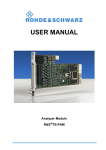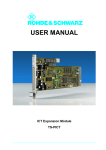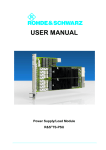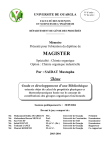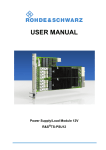Download USER MANUAL - Rohde & Schwarz
Transcript
USER MANUAL Analyzer Module TS-PAM User Manual for ROHDE & SCHWARZ Analyzer Module TS-PAM 4th Issue / 11.05 / D 1152.3808.12 All rights, also translation into foreign languages, are reserved. No part of this manual is permitted to be reproduced in any form (print, photocopy or any other method), also not for the preparation of lectures, or processed, reproduced or made available using electronic systems without written permission from ROHDE & SCHWARZ. © The passing on to third parties and the reproduction of this documentation, utilisation and communication of its contents is not permitted unless specifically approved. Infringements will incur claims for damages. All rights reserved in the case of the award of a patent or registration of a design. We draw to your attention that the names of software and hardware used in the User Manual, and the brand names of the respective companies are, in general, the subject of protection as trademarks, or under proprietary rights, or patent law. ROHDE & SCHWARZ GmbH & Co. KG Corporate Headquarters Mühldorfstr. 15 D-81671 München Telephone: Fax: ...49 (0)89/4129-13774 ...49 (0)89/4129-13777 Printed in the Federal Republic of Germany. Errors excepted, subject to technical change without notice. Safety Instructions Attention! Electrostatic sensitive devices require special care Support Center Telephone Europe: +49 180 512 42 42 Telephone worldwide: +49 89 4129 13774 Fax: +49 89 4129 13777 e-mail: [email protected] If you have any technical queries about this Rohde & Schwarz equipment, our Hotline at the Support Center of Rohde & Schwarz Sales-GmbH will be glad to help. Our team will discuss your queries and look for solutions to your problems. The Hotline is open Mondays to Fridays from 08.00 to 17.00 hrs. For queries outside office hours, you can leave a message or send a note via fax or email. We will then get back to you as soon as possible. Analyzer Module TS-PAM Content Content 1 Applications 1-1 1.1 General 1-1 1.2 Features of the TS-PAM 1-2 1.3 Features of the TS-PDC Module 1-3 2 View 2-1 3 Block Diagram 3-1 4 Design 4-1 4.1 Mechanical Design of the Module TS-PAM 4-1 4.2 Display elements of the module TS-PAM 4-3 4.3 Mechanical Design of TS-PDC 4-4 4.4 Display Elements of the Module TS-PDC 4-5 5 Description of Functions 5-1 5.1 Description of Functions of the Module TS-PAM 5-1 5.1.1 Acquisition Unit 5-1 5.1.2 Inputs and Measurement Ranges 5-2 5.1.3 Timing Control, Scanner 5-5 5.1.4 Synchronization, Trigger 5-5 5.1.5 Memory 5-6 5.1.6 Signal processing, Filter 5-7 5.1.7 Analog Bus Access 5-7 5.1.8 Measuring Functions 5-7 5.1.9 Particulars of Floating Measurements 5-8 5.1.10 Information for Operation with Dangerous Voltages 5-13 5.1.11 Power Supply 5-14 4th Issue 11.05 5.2 6 7 Description of Functions of the Module TS-PDC 5-15 Commissioning 6-1 6.1 Installation of the Plug-in Module 6-1 6.2 Installation of the Module TS-PDC 6-2 Software 7-1 7.1 7-1 Driver Software 1 Content 8 9 Analyzer Module TS-PAM 7.2 Soft Panel 7-2 7.3 Signal Analysis Library 7-4 7.4 Programming example TS-PAM 7-5 Self-test 8-1 8.1 LED Test 8-1 8.2 Power-on test 8-2 8.3 Self-test by the driver 8-2 Interface Description 9-1 9.1 Interface Description TS-PAM 9-1 9.1.1 Connector X1 9-1 9.1.2 Connector X20 9-2 9.1.3 Connector X10 9-3 9.1.4 Connector X30 9-5 9.2 Interface Description TS-PDC 9-6 9.2.1 9-6 10-1 4th Issue 11.05 10 Technical Data Connector X20 (Extension Connector) 2 Analyzer Module TS-PAM Figures 4th Issue 11.05 Figures Figure 2-1 View of the TS-PAM ...........................................................................2-1 Figure 2-2 View of the Rear I/O Module TS-PDC ...............................................2-2 Figure 3-1 Block diagram of TS-PAM with TS-PDC in the CompactTSVP...... 3-1 Figure 3-2 Block diagram of Analyzer Module TS-PAM ...................................3-2 Figure 3-3 Block diagram of Rear I/O Module TS-PDC.....................................3-3 Figure 4-1 Arrangement of the connectors and LEDs on the module TS-PAM ...............................................................................................4-1 Figure 4-2 Arrangement of the LEDs on the module TS-PAM .........................4-3 Figure 4-3 Arrangement of the connector and LEDs on the module TS-PDC 4-4 Figure 4-4 Arrangement of the LEDs on the module TS-PDC .........................4-5 Figure 5-1 Functional blocks of TS-PAM ...........................................................5-1 Figure 5-2 Signal inputs and scanner of an acquisition unit (path A) ............5-4 Figure 5-3 Trigger unit.........................................................................................5-6 Figure 5-4 Grounding procedure “Simple Single-ended Grounding” ............5-8 Figure 5-5 Grounding procedure “Single-ended, Grounding on Unit under Test”.........................................................................................5-9 Figure 5-6 Grounding procedure “Floating with Potential as Reference” ...5-10 Figure 5-7 Grounding procedure “Differential Measurement with two Channels”.........................................................................................5-11 Figure 5-8 Grounding procedure “Differential Measurement at High Reference Potential” .......................................................................5-12 Figure 5-9 Permitted voltages on analog bus lines ........................................5-13 Figure 5-10 Block schematic diagram of Rear I/O Module TS-PDC ................5-15 Figure 7-1 Soft Panel TS-PAM ............................................................................7-2 Figure 7-2 Soft Panel TS-PAM switching...........................................................7-3 Figure 9-1 Connector X1 (view: plug side) ........................................................9-1 Figure 9-2 Connector X20 (view: plug side) ......................................................9-2 Figure 9-3 Connector X10 (view: front panel) ...................................................9-3 Figure 9-4 Connector X30 (view: plug side) ......................................................9-5 Figure 9-5 Connector X20 (view: plug side TS-PDC)........................................9-6 3 Analyzer Module TS-PAM 4th Issue 11.05 Figures 4 Analyzer Module TS-PAM Tables Tables Features TS-PAM ...............................................................................1-2 Table 4-1 Connectors on the TS-PAM ..............................................................4-2 Table 4-2 Display elements on the module TS-PAM .......................................4-3 Table 4-3 Connector of the module TS-PDC....................................................4-4 Table 4-4 Display elements on the module TS-PDC .......................................4-5 Table 5-1 Measurement ranges.........................................................................5-3 Table 7-1 Driver installation TS-PAM................................................................7-1 Table 7-2 Installation of the signal analysis library ........................................7-4 Table 8-1 Statements about the LED Test........................................................8-1 Table 8-2 Statements about the power-on test................................................8-2 Table 9-1 Pin assignment for connector X1.....................................................9-1 Table 9-2 Pin assignment for connector X20...................................................9-2 Table 9-3 Pin assignment for connector X10 (view front panel).................... 9-3 Table 9-4 Pin assignment for connector X30...................................................9-5 Table 9-5 Pin assignment for connector X20 (TS-PDC)..................................9-6 4th Issue 11.05 Table 1-1 5 Analyzer Module TS-PAM 4th Issue 11.05 Tables 6 Analyzer Module TS-PAM Applications 1 Applications 1.1 General This manual describes the function and operation of the Analyzer Module TS-PAM (wave form analyzer) for use in the Test System Versatile Platform CompactTSVP. The hardware is designed as a CompactPCI module which occupies only one slot in the front side of the TSVP. The accompanying Rear I/O Module TS-PDC (DC/DC Transformer Module) is plugged into the same slot on the back side. The following analyses are possible using the Analyzer Module TS-PAM and the Signal Analysis Library: • Voltage and voltage changes with different qualifications • Time measurements • Events • Wave-form comparison The wave form analyzer is able to record electrical signals on two measuring paths (channels) at a high sampling rate of 20 MHz or on up to eight measuring paths (channels) in the „Scan“operation (quasi simultaneous) at a the low sampling rate of 5 MHz. The signals can be evaluated after acquisition with respect to parameters such as voltage, time, frequency, events. The measurement options can, in many cases, replace a digital voltmeter (DVM), a timer/counter or a digital oscilloscope. The Analyzer Module TS-PAM covers the application range above a fast sampling voltmeter (e.g. TS-PSAM or data acquisition module with scanner). 4th Issue 11.05 A wide range of trigger options for acquisition of the correct measuring interval and automatic analysis options in the actual production environment, where no optical evaluation of the signals can take place, ensure the reproducibility of the measurements. The Test System Versatile Platform CompactTSVP TS-PCA3 allows you to plug in measuring and control modules according to industry standard CompactPCI or PXI. Apart from this, Rohde & Schwarz modules use an expanded printed circuit board format and have access to a special analog measurement bus. 1-1 Applications Analyzer Module TS-PAM 1.2 Features of the TS-PAM Features TS-PAM Two fully independent, floating acquisition units with working voltage up to 125 VDC Acquisition modes with up to 8 single-ended or 4 differential channels High sampling rate 20 MSamples/s for two channels Multi channel signal recording for up to 8 channels at 5 MSamples/s Synchronous acquisition of 8 programable comparator signals and PXI-trigger additionally Wide dynamic range with 14 bit resolution Input ranges ±0.2 VDC up to ±100 VDC ( 125 V max.)) 3:1 relay multiplexer per channel 2 x 1 MSamples memory depth Analog and digital trigger signals Analog measurement bus access to 8 bus lines Selftest capabilities Soft front panel support for direct operation LabWindows/CVI driver support GTSL test software library in DLL format 4th Issue 11.05 Table 1-1 Features TS-PAM 1-2 Analyzer Module TS-PAM Applications 1.3 Features of the TS-PDC Module The Rear I/O Module TS-PDC is used as a floating DC voltage source for the Analyzer Module TS-PAM . It contains two identical DC/DC converters. The following floating voltages are obtained from an input voltage of 5 VDC: +15 VDC ±5%, 0.5A (2x) – -15 VDC ±5%, 0.5A (2x) – +5 VDC ±5%, 0.5A (2x) – +3.3 VDC ±5%, 0.25A (2x) 4th Issue 11.05 – 1-3 Analyzer Module TS-PAM 4th Issue 11.05 Applications 1-4 Analyzer Module TS-PAM View 2 View Figure 2-1 shows the Analyzer Module TS-PAM without the accompanying Rear I/O Module TS-PDC. The Rear I/O Module TS-PDC is shown in Figure 2-2 . 4th Issue 11.05 Figure 2-1 View of the TS-PAM 2-1 View Analyzer Module TS-PAM 4th Issue 11.05 Figure 2-2 View of the Rear I/O Module TS-PDC 2-2 Analyzer Module TS-PAM Block Diagram 3 Block Diagram Figure 3-1 shows the simplified functional block diagram of the Analyzer Module TS-PAM and the Rear I/O Module TS-PDC in the CompactTSVP . Figure 3-2 shows the block diagram of the Analyzer Modules TS-PAM . Figure 3-3 shows the block diagram of the Rear I/O Module TS-PDC. 4th Issue 11.05 Figure 3-1 Block diagram of TS-PAM with TS-PDC in the CompactTSVP 3-1 3-2 Figure 3-2 Block diagram of Analyzer Module TS-PAM 4th Issue 11.05 SRAM Control Logic (FPGA) DC I S O L A T I O N I S O L A T I O N DC DC Control Logic PLD ADC REF Control Logic PLD ADC REF Differential cPCI Interface FPGA Boot Loader EEPROM PLL PXI_TRIG 8 PXI_CLK GA 5 DC Lo Hi Lo Hi Filter 400,100k, Full BW Filter 400,100k, Full BW Filter 400,100k, Full BW Filter 400,100k, Full BW Fast Diff Scan 2x 1:4 Fast Diff Scan 2x 1:4 Comp DAC Comp DAC Comp DAC Comp DAC REF DAC Comp DAC Comp DAC Comp DAC Comp Gain x1.6,x4 Gain x1.6,x4 Gain x1.6,x4 Gain x1.6,x4 Gain x1.6,x4 Gain x1.6,x4 Gain x1.6,x4 Gain x1.6,x4 Attenuator 1,2,10,20,100,200 Attenuator 1,2,10,20,100,200 Attenuator 1,2,10,20,100,200 Attenuator 1,2,10,20,100,200 Attenuator 1,2,10,20,100,200 Attenuator 1,2,10,20,100,200 Attenuator 1,2,10,20,100,200 Attenuator 1,2,10,20,100,200 Hi Hi Hi Hi Hi Hi Hi Hi CHB_LO CHA_LO Input Multiplexer GND GND Path A Path B REF A1 A2 B1 B2 C1 C2 D1 D2 CHB_LO1 CHB4_HI1 CHB_HI2 CHB4_HI3 CHB3_HI1 CHB3_HI2 CHB3_HI3 CHB2_HI1 CHB2_HI2 CHB2_HI3 CHB1_HI1 CHB1_HI2 CHB1_HI3 CHA_LO1 CHA4_HI1 CHA4_HI2 CHA4_HI3 CHA3_HI1 CHA3_HI2 CHA3_HI3 CHA2_HI1 CHA2_HI2 CHA2_HI3 CHA1_HI1 CHA1_HI2 CHA1_HI3 LABA2 LABB2 LABC2 LABD2 GND LABA1 LABC1 LABC1 LABD1 Block Diagram Analyzer Module TS-PAM Differential +5 V GND Block Diagram Regulator 1 +15 V +5 V +3.3 V COM -15 V Regulator 2 +15 V +5 V +3.3 V COM -15 V primary DC-Transducer ON/OFF X 20 Analyzer Module TS-PAM INHIBIT 4th Issue 11.05 Figure 3-3 Block diagram of Rear I/O Module TS-PDC 3-3 Analyzer Module TS-PAM 4th Issue 11.05 Block Diagram 3-4 Analyzer Module TS-PAM Design 4 Design 4.1 Mechanical Design of the Module TS-PAM The Analyzer Module TS-PAM is designed as a long cPCI plug-in module for mounting in the front of the CompactTSVP. The insertion depth is 300 mm. The board height of the module is 4 HU. 4th Issue 11.05 In order to ensure that it is inserted correctly into the CompactTSVP, the front panel is furnished with a locating pin. The module is secured in place with the two retaining screws on the front panel. Front connector X10 is used for connecting the UUTs. Connector X30 connects the TS-PAM module to the analog bus backplane in the CompactTSVP. The Connectors X20/X1 connect the TS-PAM module to the cPCI backplane/PXI control backplane. Figure 4-1 Arrangement of the connectors and LEDs on the module TS-PAM 4-1 Design Analyzer Module TS-PAM Name Use X1 cPCI connector X10 Front connector X20 cPCI connector X30 Analog bus connector 4th Issue 11.05 Table 4-1 Connectors on the TS-PAM 4-2 Analyzer Module TS-PAM Design 4.2 Display elements of the module TS-PAM Figure 4-2 Arrangement of the LEDs on the module TS-PAM On the front side of the module TS-PAM there are three LEDs which show the current status of the module. The LEDs have the following meaning: 4th Issue 11.05 LED Description red Fault condition: Lights up when a fault is detected on the TS-PAM module during the power-on test after the supply voltage is switched on. This means that there is a hardware problem on the module. (also see section 8: Self-test) yellow Communication: Lights up when data is exchanged across the interface. green Supply voltage OK: Lights up when all necessary supply voltages are present (incl. the TS-PDC voltages). Table 4-2 Display elements on the module TS-PAM 4-3 Design Analyzer Module TS-PAM 4.3 Mechanical Design of TS-PDC The module TS-PDC is a Rear I/O Module for insertion in the back side of the CompactTSVP. The printed circuit board height of the module is 3 HU (134 mm). The module is attached with both fastening screws of the front panel. The connector X20 connects the module TS-PDC with the extension back panel in the CompactTSVP. The module TS-PDC must always use the corresponding rear I/O slot for the main module (e.g. module TS-PAM ). WARNING! The module TS-PDC must always be plugged into the corresponding rear I/O slot (same slot code) of the module TS-PAM . If it is not correctly plugged in (e.g. cPCI/PXI standard modules in the front area) both modules may be destroyed. Figure 4-3 Arrangement of the connector and LEDs on the module TSPDC X20 Use Extension (Rear I/O) Table 4-3 Connector of the module TS-PDC 4-4 4th Issue 11.05 Name Analyzer Module TS-PAM Design 4.4 Display Elements of the Module TS-PDC Figure 4-4 Arrangement of the LEDs on the module TS-PDC Eight light-emitting diodes (LEDs) are located on the front of the TS-PDC module to show the current status of the generated supply voltages. The individual LEDs have the following meanings: LED Description 1, lights up +15 VDC (CHA), present 2, lights up +5 VDC (CHA), present 3, lights up +3.3 VDC (CHA), present 4, lights up -15 VDC (CHA), present 5, lights up +15 VDC (CHB), present 6, lights up +5 VDC (CHB), present 7, lights up +3.3 VDC (CHB), present 8, lights up -15 VDC (CHB), present 4th Issue 11.05 Table 4-4 Display elements on the module TS-PDC 4-5 Analyzer Module TS-PAM 4th Issue 11.05 Design 4-6 Analyzer Module TS-PAM Description of Functions 5 Description of Functions 5.1 Description of Functions of the Module TS-PAM The Analyzer Module TS-PAM is a signal analyzer similar to a multichannel digital storage oscilloscope (DSO). It has two acquisition units, which can be operated separately or synchronized. Thus, the TS-PAM functions as two separate digital oscilloscopes or as a digital oscilloscope with twice the number of channels. The two acquisition units are separated according to control/software as well as potential. Because each path is floating, each path can be connected to a different potential and measured there with high accuracy of measurement. Naturally the paths can also be grounded, as with digital oscilloscopes. Path A Acquisition Unit A Attenuator/ Gain Scanner Filter ADConverter WaveformMemory Trigger A Sequence Control A Trigger B Sequence Control B Path B Attenuator/ Gain Scanner Filter ADConverter WaveformMemory Acquisition Unit B Figure 5-1 Functional blocks of TS-PAM 5.1.1 Acquisition Unit 4th Issue 11.05 Each acquisition unit has four channels with individually adjustable gain. In single-channel mode, two channels or one channel and the floating reference potential can be statically selected. The A/D converter measures the difference signal with maximum sample rate. With two acquisition units, two signals with conversion rates up to 20 MHz can be recorded, which corresponds to a sampling period of 50 ns. 5-1 Description of Functions Analyzer Module TS-PAM In multi-channel mode, two to four signals of a path can be quasi-simultaneously acquired. The channels are scanned and recorded with time offset. At the maximum sampling frequency of 20 MHz, the effective sampling frequency for four aquisition channels is 5 MHz, the interval delta time (offset) is 50 ns. You can select whether the difference between individual channels or the difference of the channels against the floating reference potential is to be measured. With two acquisition units, a total of eight channels can be simultaneously recorded. Because in most cases, the floating potentials can serve as a reference or even be measured single-ended against GND, all eight channels can be used and there is seldom need to take the difference between two channels. The reference potential of a path is connected to GND or different reference potential of the unit under test. With particularly sensitive units under test, it is possible that the test signal may be distorted if the reference potential of a path is connected directly to the unit under test (cause: The reference potential has a higher capacitance and higher leakage current to GND compared to an input). This can be avoided by using two channels of a unit and measuring fully differential with two high-impedance inputs. In the standby state after software initialization, each acquisition unit is connected to GND through a relay and a resistor, for reasons of signal technology. During floating operation, this relay is automatically opened when a connection is made to a front connector pin or to the analog bus. During grounded operation, when the GND relay remains closed, care must be taken that the relay and resistor are not overloaded. Each measuring channel can be switched with relays to three input channels, to four lines of the local analog bus LABxy, to the reference potential CHA_LO or CHB_LO or to the analog output for the trigger threshold of the comparator. If the local analog bus line is used as an additional input, 4 x 8 = 32 pins on the connector X10 can be measured without having to use a relay in the adapter or an additional plug-in card. If the local analog bus LAB is connected with the global analog bus AB, up to eight channels can be simultaneously measured and there is access to an almost unlimited number of measuring points ( 90 channels per plug-in module TS-PMB). Here too, single-ended and differential measurements are possible. 5-2 4th Issue 11.05 5.1.2 Inputs and Measurement Ranges Analyzer Module TS-PAM Description of Functions Each measuring channel has a programmable input divider and measurement amplifier. With nine measurement ranges from 0.2 V to 100 V, small to high voltages can be optimally acquired with 14 bit resolution. In the small measurement ranges, instead of the normal input impedance of 1 MΩ, higher impedances can be measured. Because the floating measuring technique is used, the measuring accuracy of the small ranges is also possible for small signals on high potential. The maximum permitted rated voltage between arbitrary pins is 125 V. Measurement range Resolution Input impedance ± 100 V 15 mV 1 MΩ ± 50 V 7.5 mV 1 MΩ ± 20 V 3 mV 1 MΩ ± 10 V 1.5 mV 1 MΩ ±5V 0.75 mV 1 MΩ or >10 MΩ selectable ±2V 0.3 mV 1 MΩ or >10 MΩ selectable ±1V 0.15 mV 1 MΩ or >10 MΩ selectable ± 0.5 V 75 µV 1 MΩ or >10 MΩ selectable ± 0.2 V 30 µV 1 MΩ or >10 MΩ selectable 4th Issue 11.05 Table 5-1 Measurement ranges 5-3 Description of Functions Analyzer Module TS-PAM Analog Bus a1 a2 b1 b2 Local Analog Bus Coupling Relays LABa1 LABa2 LABb1 LABb2 relay cross point = Fast Scanner c1 c2 d1 d2 LABc1 LABc2 LABd1 LABd2 Scope Channels CHA1 Input Channels CHA1_HI1 CHA1_HI2 CHA1_HI3 DAC CHA2 CHA2_HI1 CHA2_HI2 CHA2_HI3 HI ADC DAC CHA3 LO CHA3_HI1 CHA3_HI2 CHA3_HI3 DAC CHA4 CHA4_HI1 CHA4_HI2 CHA4_HI3 DAC CHA_LO1 50 CHA_LO GND Figure 5-2 Signal inputs and scanner of an acquisition unit (path A) The inputs are DC coupled. An AC coupling can be done by connecting an external capacitor in series. The time constant is optimized by the appropriate selection of R and C on the measuring frequency and the desired transient time. Four programmable analog sources (DAC) per acquisition unit set the trigger threshold of the comparators of each channel and can be connected as a control voltage source for the self-test to the analog bus. The programming is according to the value of the trigger threshold and 5-4 4th Issue 11.05 Signals can be recorded within the input bandwidth. Similarly to digital oscilloscopes, no anti-aliasing filter is provided. For signal conditioning, hardware low pass filters can be connected in series. Analyzer Module TS-PAM Description of Functions the set measurement range. 5.1.3 Timing Control, Scanner The sampling rate can be varied so that slow or fast signals are optimally acquired and stored in the wave form memory. Because the timing of each acquisition unit can be independently set, slow and fast signals can be simultaneously optimally acquired, which results in a considerably better use of the wave form memory and effectively increases its depth. Depending on whether the single-channel or multi-channel operating mode is used, the sampling rate can be max. 20 MHz or 5 MHz. The precise time reference is derived from the 10 MHz PXI clock of the Test System Versatile Platform CompactTSVP. 5.1.4 Synchronization, Trigger Each acquisition unit can be started through the software, through the test signals, external trigger inputs or PXI trigger inputs (from other modules). For triggering through the test signals, analog comparators with programmable threshold and selectable flanks are used. Trigger output signals can trigger other modules on the front connector X10 or on the PXI trigger bus. Through the pins XTO1 and XTO2, the trigger time points of both acquisition units or the eight analog trigger signals can be fed out. These signals can also be fed to the eight PXI trigger lines. 4th Issue 11.05 The acquisition units can begin the recording synchronously, independently or initiated by the other acquisition unit. The storage in the wave form memory can be done pre- or post-trigger. 5-5 Description of Functions Analyzer Module TS-PAM Acquisition Unit A Start/Stop PXI Trigger 0...7 8 XTI 1,2 2 8 DLY IT1_A PXI 0...7 IT1_A Analog Trigger AT A1...B4 XTI 1 AT A1...B4 8 Software IT1_A IT1_B AT A1...B4 XTI 1 XTI 2 XTO 1 2 8 DLY IT1_B IT1_B XTI 2 AT A1...B4 XTO 2 Acquisition Unit B Start/Stop Figure 5-3 Trigger unit The wave form memory contains 1 MSamples (of 32 Bit width) per acquisition unit. This means that in the single-channel mode, two channels (each acquisition unit) can record a maximum of 1 MSamples each. In the multi-channel mode, eight channels up to a depth of 256 ksamples each can be measured. In addition to the analog values, the trigger information from the PXI-Bus and the analog comparators is also recorded. 5-6 4th Issue 11.05 5.1.5 Memory Analyzer Module TS-PAM Description of Functions 5.1.6 Signal processing, Filter The measuring channels are broadband and have, like digital oscilloscopes, no specific anti-aliasing filters. For noise suppression, a 100 kHz or 400 Hz filter can be connected in the path. It has to be observed that the filters are arranged behind the measuring scanner. The filters only function correctly if the filter cut-off frequency is distinctly higher than the scan frequency. Otherwise, a distortion of the measurement value can occur up to an identical test signal of all channels. An additional filtering can be obtained with the digital filter (low pass filter with cut-off frequency 0.2 x sampling frequency). Additional special filter features can be implemented with software by processing of the waveform arrays with commercially available programs. 5.1.7 Analog Bus Access Each input channel has direct access to four local analog bus lines and through coupling relays to the global analog bus. Thus, a total of eight channels can be simultaneously connected to the analog bus. Instead of an input channel, the floating reference potential CHA_LO or CHB_LO can be switched to the analog bus. In this way, the measuring channels can measure signals from other switch modules, and signals to the connector X10 can also be connected to other measuring modules. When there is signal feed through the analog bus and other cards, it must be noted that the best signal quality is obtained only for short signal paths. Signals to the connector X10 can therefore be best measured. 4th Issue 11.05 5.1.8 Measuring Functions The acquisition units can record analog signals and at the same time digital trigger signals within a given time. An analysis of the wave forms can be done with the Signal Analysis Library (see Software Analysis Library in Section 7.3). 5-7 Description of Functions Analyzer Module TS-PAM 5.1.9 Particulars of Floating Measurements To make optimum use of the possibilities of floating measurement of TS-PAM, it is important to look at the grounding. The unit under test or the measuring instrument must be grounded in order to obtain reproducible, stable measuring results. Only with very slow measuring techniques (battery operated hand multimeters) the hum can be equalized by decelerating averaging. For fast and accurate measurements, one must give some thought to the grounding. It is important here to only provide a single grounding point. See examples Figure 5-4 to Figure 5-8 . a) Simple Single-ended Grounding CHA1_HI ADC Single-ended, separate GND HI LO 1 2 3 CHA1_HI2 60V CHA_LO CHA_LO1 DUT 50 Figure 5-4 Grounding procedure “Simple Single-ended Grounding” In the simplest case (Figure 5-4 ) with low accuracy requirements, grounding is done “somewhere”, i.e. the unit under test is grounded in the fixture, the measuring unit is internally connected to GND. Advantage: Only the test signals are considered; the grounding is connected in some way. The connection becomes very simple. If the signals are fed through the analog bus, you save one bus line for the GND. When there is a small difference in the grounding potentials, transient currents flow which distort the measurement. The LO input of the measuring unit is not arbitrarily low resistant but connected to ground through approx. 50 Ω; faults up to 50 mV can be caused by derivative currents. This type of connection has the hidden danger that one may inadvertently place a grounded voltage on CHA_LO. Thus, there may be a higher current which destroys the relay con- 5-8 4th Issue 11.05 Disadvantage: Low accuracy, particularly for signals in the magnitude of 100 mV and lower. Analyzer Module TS-PAM Description of Functions tacts. Therefore, there is here a PTC resistor with a approx. 50 Ω resistance built in, which limits this current. However, it must be ensured that neither the max. current of the GND relay (500 mA) nor the switching power of 15 W are exceeded. Measurement a) is used for digital oscilloscopes and non-differential A/D converter cards. There is no option to separate the acquisition unit from GND for these devices. b) Single-ended, Grounding on the Unit under Test CHA1_HI ADC HI LO 2 3 DUT CHA_LO Single-ended, one common GND at DUT 60V CHA_LO1 50 Figure 5-5 Grounding procedure “Single-ended, Grounding on Unit under Test” With this wiring (Figure 5-5), the floating character of the acquisition unit of TS-PAM is used to ground only on the low-resistance ground point of the unit under test (grounding only on one point). Advantage: Accurate measurements even at low voltages, no ground loops or potential differences, because there is only a single ground point. 4th Issue 11.05 Disadvantage: The CHA_LO must be specifically connected with relays and wired in the fixture. When there is signal feed through the analog bus, an additional bus line is necessary. 5-9 Description of Functions Analyzer Module TS-PAM c) Floating with Potential as Reference CHA1_HI ADC HI LO 1 2 3 CHA_LO Floating, CHA_LO as reference CHA_LO1 0.1 V 60V 50 Figure 5-6 Grounding procedure “Floating with Potential as Reference” With this wiring, (Figure 5-6 ) the measuring unit can be operated on a deviating, higher potential (instead of being grounded). Advantage: Despite a voltage of 60 V e.g. , the smallest ranges and not the 100-V range can be used to measure the current. The common mode suppression is nearly ideal using the floating measuring technique. Disadvantage: The „cold“ connection CHA_LO is not exactly equal to the „hot“ signal connection (CHA1_HI2). The LO connection has a greater capacity (to the order of 1 nF) to ground and exhibits greater leak currents between LO and GND. In most cases this capacity can change the signal on the unit under test. Therefore LO must be applied to a low resistant point of the unit under test. In the example of the current measurement by the voltage drop at a resistor, this is the side facing the source. 4th Issue 11.05 Digital oscilloscopes and non-differential A/D converter cards must use two channels for this. Otherwise, they can only measure in the inaccurate large measurement ranges (60 V). Even differential A/D converter cards must use the large measurement ranges and lose accuracy. 5-10 Analyzer Module TS-PAM d) Description of Functions Differential measurement with two Channels ADC HI CHA1_HI LO Differential, floating, second channel as reference 2 3 CHA1_HI2 0.1 V 60V CHA2_HI 1 2 3 CHA2_HI1 CHA_LO CHA_LO1 50 Figure 5-7 Grounding procedure “Differential Measurement with two Channels” Similarly to c), with this wiring (Figure 5-7 ), measurement can be done on a different potential. However, a high-resistance separate channel with low capacitance is used as reference. For reproducible measurements the input ranges with 1 MΩ input resistance must be used. This reistance must be selected specifically in the small measuring ranges. Reason: Since the acquisition unit is operated here without direct reference potential, leak currents of the operational amplifier cannot otherwise flow to the reference potential CHA_LO. Advantage: The high-resistance input from CHA2_HI1 distorts the signal on the unit under test very little. Measurement can be done in the more accurate small measurement ranges. 4th Issue 11.05 Disadvantage: An additional channel is necessary. 5-11 Description of Functions Analyzer Module TS-PAM e) Differential Measurement at High Reference Potential ADC HI CHA1_HI LO Differential, floating, DUT high potential as reference CHA2_HI 1 2 3 1 2 3 +5V -5V 60V CHA_LO CHA_LO1 50 Figure 5-8 Grounding procedure “Differential Measurement at High Reference Potential” The wiring as in Figure 5-8 is optimally suited when a unit under test has a larger portion of the circuit at a higher reference potential than the other grounded circuit. The reference potential of the acquisition unit is connected to the reference potential of unit under test (60 V in the example, broken line). Advantage: All measurements can be carried out in the small, more accurate measurement ranges. Single-ended measurements against the reference potential or differential measurements between various signals of the high potential can be carried out. Fewer analog bus lines are necessary. Disadvantage: It must be noted which signals belong to the high reference potential and a line for this provided. There is danger of a short circuit between GND and high reference potential. 4th Issue 11.05 It must be ensured that one does not inadvertantly close the GND relay and thus cause a short circuit. 5-12 Analyzer Module TS-PAM Description of Functions 5.1.10 Information for Operation with Dangerous Voltages The following voltages are considered “dangerous live” under EN 61010-1. • 70 V DC • 33 V AC eff • 46.7 V AC peak CAUTION! When operating the Analyzer Module TS-PAM above these voltage limits, the instructions under EN 61010-1 must be followed. The Analyzer Module TS-PAM and the Test System Versatile Platform CompactTSVP are designed for a maximum voltage of 125 V between floating measuring components, analog buses and GND. It must be ensured that this limit is not exceeded at any time, even at summation of the voltages, even through alternating signals. Figure 5-9 shows some typical permissible voltage configurations between analog buses and ground. 0...125 V Analog bus 0...125 V - 125 V 5V 125 V 125 V max 125 V max 125 V max floating 125 V max!! 125 V max!! 0...125 V 125 V max!! 120 V 125 V max!! 125 V GND referenced signals Figure 5-9 Permitted voltages on analog bus lines 4th Issue 11.05 For reasons of fire safety, it is recommended in EN 61010-1 that for DC-sources, the current or the rating be limited to 150 VA. 5-13 Description of Functions Analyzer Module TS-PAM 5.1.11 Power Supply 4th Issue 11.05 The digital portion of the Analyzer Module TS-PAM is supplied with power of +5 V and +3.3 V of the CompactPCI Bus. The two floating measuring portions are each supplied with a set of floating voltages, +5 V, +3.3 V, +15 V, -15 V from the rear I/O module TS-PDC (DC/DC converter). The associated capacity is taken from the 5-V-CompactPCI supply. 5-14 Analyzer Module TS-PAM Description of Functions 5.2 Description of Functions of the Module TS-PDC The Rear I/O Module TS-PDC is configured as a primary reference DC/DC converter. The input voltage (5 VDC) is transfered to two secondary potentials and rectified to the nominal voltage by line controllers. The status of the output voltage is displayed in each case by an LED. – +15 VDC, 0.5A (2x) – -15 VDC, 0.5A (2x) – +5 VDC, 0.5A (2x) – +3.3 VDC, 0.25A (2x) +5 V GND ON/OFF Regulator 1 +15 V +5 V +3.3 V COM -15 V Regulator 2 +15 V +5 V +3.3 V COM -15 V primary DC-Transducer X 20 The following DC voltages are generated: INHIBIT 4th Issue 11.05 Figure 5-10 Block schematic diagram of Rear I/O Module TS-PDC 5-15 Analyzer Module TS-PAM 4th Issue 11.05 Description of Functions 5-16 Analyzer Module TS-PAM Commissioning 6 Commissioning 6.1 Installation of the Plug-in Module • Power down and switch off the CompactTSVP. • Select a suitable front slot (slots 5-15 possible). • Remove the corresponding front panel portion from the TSVP chassis by loosening the two screws. WARNING! Check the backplane connectors for bent pins! Any bent pins must be straightened! Failure to do this may permanently damage the backplane! • Apply moderate pressure to insert the plug-in module (use locating pin to attach). WARNING! To insert the plug-in module, use both hands to guide carefully into the backplane connectors. • The module is correctly located when a distinct “stop” can be felt. • Tighten the two retaining screws on the front panel of the module. WARNING! 4th Issue 11.05 Install the associated TS-PDC rear I/O module as described in Section 6.2 . 6-1 Commissioning Analyzer Module TS-PAM 6.2 Installation of the Module TS-PDC To install the plug-in module, proceed as follows: • The TS-PAM module must have been installed beforehand. • Select the corresponding rear I/O slot for the TS-PAM module. • Remove the corresponding rear panel portion from the CompactTSVP chassis by loosening the two screws. WARNING! Check the backplane connectors for bent pins! Any bent pins must be straightened! Failure to do this may permanently damage the backplane! • Push in the plug-in module using moderate pressure. WARNING! To insert the plug-in module, use both hands to guide carefully into the backplane connectors. The module is correctly located when a distinct “stop” can be felt. • Tighten the two retaining screws on the front panel of the module. 4th Issue 11.05 • 6-2 Analyzer Module TS-PAM Software 7 Software 7.1 Driver Software For the functions of the signal recording of the Analyzer Module TS-PAM , a LabWindows IVI SCOPE driver is available. All other functions of the hardware are served by specific extensions of the driver. The driver is a component of the ROHDE & SCHWARZ GTSL software. All functions of the driver are fully documented in the online help and in the LabWindows/CVI Function Panels. During driver installation, the following software modules are installed: Module Path Comment rspam.dll <GTSL directory>\Bin Driver rspam.hlp <GTSL directory>\Bin Help file rspam.fp <GTSL directory>\Bin LabWindows CVI Function Panel file, function panels for CVI development interface rspam.sub <GTSL directory>\Bin LabWindows CVI attribute file. This file is required by some „function panels“. rspam.lib <GTSL directory>\Bin Import Library rspam.h <GTSL directory>\Include Header file for the driver Table 7-1 Driver installation TS-PAM NOTE: 4th Issue 11.05 To use the driver, the IVI and VISA libraries from National Instruments are necessary. 7-1 Software Analyzer Module TS-PAM 7.2 Soft Panel For the Analyzer Module TS-PAM, there is a Soft Panel available (Figure 7-1 ). The Soft Panel is based on the LabWindows CVI driver. The Software Panel enables interactive operation of the module. The measured values are displayed graphically. 4th Issue 11.05 Figure 7-1 Soft Panel TS-PAM 7-2 Analyzer Module TS-PAM Software 4th Issue 11.05 The switching of the signal path of TS-PAM can be done through the Soft Panel (Figure 7-2 ). Figure 7-2 Soft Panel TS-PAM switching 7-3 Software Analyzer Module TS-PAM 7.3 Signal Analysis Library The Signal Analysis Library offers functions for the analysis of the signals recorded by the Analyzer Module TS-PAM . The following signal parameters can be determined: • Frequency, period • Average value, RMS • Rise and fall times • Pulse width • Maximum and minimum values (absolute and relative maxima/minima) • Event counting (slopes, minima, maxima) • Time measurement between two events In addition, the Signal Analysis Library offers the following functions: • Wave form comparison • Calculation of reference wave forms • Loading and saving of the wave forms as files • Display of signal waves with reference curves and markers Module Path Comment siganl.dll <GTSL directory>\Bin Driver siganl.hlp <GTSL directory>\Bin Help file siganl.fp <GTSL directory>\Bin LabWindows CVI Function Panel file, function panels for CVI development interface siganl.lib <GTSL directory>\Bin Import Library siganl.h <GTSL directory>\Include Header file for the driver The analysis of audio signals is possible with the Audio Analysis Library TS-LAA. This library offers the following functions: 7-4 • RMS calculation • Single/Multitone frequency response • Distortion factor • Filter (low-pass, high-pass, band-pass, band-stop, CCIR weighted/unweighted) 4th Issue 11.05 Table 7-2 Installation of the signal analysis library Analyzer Module TS-PAM • Software Windowing of the signal 7.4 Programming example TS-PAM The following sample program shows the recording of a signal which contacts the connections CHA1_HI1 and CHA_LO1 on the front side connector. /* This sample shows the acquisition of analog wave forms using the TS-PAM module. Error handling is not considered in this sample in order to keep it easy to read. The return status should be checked for VI_SUCCESS after each driver call. */ #include <ansi_c.h> #include <userint.h> #include "rspam.h" int main (int argc, char *argv[]) { ViSession vi; ViStatus status; ViReal64 ViInt32 ViReal64 ViReal64 * pWaveform = VI_NULL; /* pointer to wave form array */ actualPoints; /* number of samples returned from */ initialX; /* time of the first sample, relative to the trigger event */ xIncrement; /* time between two samples */ /* Open a session to the device driver. The resource descriptor depends on the slot number of the TS-PAM module and must be adapted to the target system. */ status = rspam_InitWithOptions ( "PXI1::13::0::INSTR", VI_TRUE, VI_TRUE, "Simulate=0,RangeCheck=1", &vi); /* 4th Issue 11.05 Configure the acquisition time base for path A: Take a minimum of 20000 samples in 1 ms - Sample frequency is 20 MHz - Trigger delay = 0, i.e. no pre- or post-triggering */ status = rspam_ConfigureAcquisitionRecordPath (vi, RSPAM_VAL_PATH_A, 1.0e-3, 20000, 0.0); /* Configure channel CHA1 for a signal between -5 V and + 5 V. The vertical range is 10 V (peak-to-peak), the offset is 0 V. */ status = rspam_ConfigureChannel (vi, "CHA1", 10.0, 0.0, RSPAM_VAL_DC, 1.0, VI_TRUE); /* 7-5 Software Analyzer Module TS-PAM Configure channel CHA1 for 1 MOhm impedance, no lowpass filter */ status = rspam_ConfigureChanCharacteristics (vi, "CHA1", 1.0e6, 20.0e6); /* Configure the trigger: - Edge trigger - Trigger level 2.5 V, positive slope */ status = rspam_ConfigureTriggerPath (vi ,RSPAM_VAL_PATH_A, RSPAM_VAL_EDGE_TRIGGER ); status = rspam_ConfigureTriggerSourcePath (vi, RSPAM_VAL_PATH_A, "CHA1", 2.5, RSPAM_VAL_POSITIVE); /* Configure the path for floating acquisition */ status = rspam_ConfigureGroundPath (vi, RSPAM_VAL_PATH_A, VI_FALSE); /* Connect the instrument to the front connector and wait until all relays have been closed */ status = rspam_Connect (vi, "CHA1_HI", "CHA1_HI1"); status = rspam_Connect (vi, "CHA_LO", "CHA_LO1"); status = rspam_WaitForDebounce ( vi, 1000 ); /* Get the actual number of points for the acquisition and allocate memory for it. Note that this value may be greater than the minimum number of samples requested above. */ status = rspam_ActualRecordLengthPath (vi, RSPAM_VAL_PATH_A, &actualPoints); pWaveform = calloc (actualPoints, sizeof(ViReal64)); /* Start the acquisition - Timeout is 1000 ms */ status = rspam_ReadWaveform (vi, "CHA1", actualPoints, 1000, pWaveform, &actualPoints, &initialX, &xIncrement); Display the wave form */ status = WaveformGraphPopup ("Waveform", pWaveform, actualPoints, VAL_DOUBLE, 1.0, 0.0, initialX, xIncrement); /* Close the driver session */ status = rspam_close ( vi ); /* 7-6 4th Issue 11.05 /* Analyzer Module TS-PAM Software free memory */ free ( pWaveform ); return 0; 4th Issue 11.05 } 7-7 Analyzer Module TS-PAM 4th Issue 11.05 Software 7-8 Analyzer Module TS-PAM Self-test 8 Self-test The Analyzer Module TS-PAM has integrated self-test capability. The following tests are possible: • LED Test • Power-on test • Self-test by the driver 8.1 LED Test When the device is switched on, all three LEDs are lit for about one second. This indicates that the 5 V supply voltage is present and all LEDs are working, also that the power-on test was successful. The following statements can be made about the different LED statuses in this power-on phase: LED Description One LED does not light up Hardware problem on the module LED faulty No LED's light up No +5V supply Table 8-1 Statements about the LED Test NOTE: 4th Issue 11.05 If diagnostics suggest a problem with the supply voltage, the LEDs for the associated rear I/O module, TS-PDC, must be inspected visually. If a supply voltage failure is confirmed, the TSPDC module must be replaced. 8-1 Self-test Analyzer Module TS-PAM 8.2 Power-on test The power-on test runs at the same time as the LED test. In this test, the result of the FPGA loading process is calculated. The following statements can be made about the different statuses of the red and green LEDs: LED Description Green LED on all supply voltages present green LED off at least one supply voltage from TS-PAM module or the TS-PDC module is not present red LED off no errors were detected red LED on The FPGA/µP was not successfully loaded Table 8-2 Statements about the power-on test NOTE: If diagnostics suggest a problem with the supply voltage, the LEDs for the associated rear I/O module, TS-PDC, must be inspected visually. If a supply voltage failure is confirmed, the TSPDC module must be replaced. 8.3 Self-test by the driver The driver which is supplied has a more extensive self-test. It is started through the standard self-test function and delivers a “PASS” or “FAIL” result. In the TSVP self-test, a test report is generated. NOTE: 4th Issue 11.05 Information on starting the self-test and on the sequence of the necessary steps can be found in the GTSL software description or the GTSL online help. 8-2 Analyzer Module TS-PAM Interface Description 9 Interface Description 9.1 Interface Description TS-PAM 9.1.1 Connector X1 25 F E D C BAZ 4th Issue 11.05 Figure 9-1 Connector X1 (view: plug side) Pin F 25 GND 24 GND 23 GND 22 GND 21 GND 20 GND 19 GND 18 GND 17 GND 16 GND 15 GND 12..14 11 GND 10 GND 9 GND 8 GND 7 GND 6 GND 5 GND 4 GND 3 GND 2 GND 1 GND E D C B A 5V 3.3V ENUM# REQ64# 5V ACK64# AD[0] V(I/O) 5V AD[1] AD[2] 5V AD[3] AD[4] 3.3V AD[5] AD[6] 3.3V GND AD[7] C/BE[0]# M66EN AD[8] AD[9] 3.3V AD[10] AD[11] V(I/O) GND AD[12] AD[13] GND AD[14] AD[15] 3.3V C/BE[1]# PAR 3.3V GND SERR# PERR# GND IPMB_SDA IPMB_SCL 3.3V LOCK# STOP# V(I/O) GND DEVSEL# TRDY# BD_SEL# IRDY# FRAME# 3.3V Key Area C/BE[2]# GND AD[16] AD[17] AD[18] AD[19] AD[20] 3.3V GND AD[21] AD[22] GND AD[23] IDSEL C/BE[3]# AD[24] AD[25] V(I/O) GND AD[26] AD[27] GND AD[28] AD[29] AD[30] AD[31] CLK 3.3V GND REQ# GNT# GND RST# BSRSV BSRSV INTS INTP V(I/O) HEALTHY# IPMB_PWR INTD# 5V INTC# INTB# INTA# TDI TDO TMS 5V TCK 5V +12V TRST# -12V 5V Z GND GND GND GND GND GND GND X1 GND GND C GND O GND N N GND E GND C GND T GND O GND R GND GND GND GND GND GND Table 9-1 Pin assignment for connector X1 9-1 Interface Description Analyzer Module TS-PAM 9.1.2 Connector X20 22 F E D C BAZ Figure 9-2 Connector X20 (view: plug side) NC = not connected, NP = not populated F GND GND GND GND GND GND GND GND E D C GA0 GA1 GA2 A GA3 GA4 GND GND GND PXI_TRIG6 GND (CAN-En) PXI_TRIG5 PXI_CLK10 PXI_TRIG7 GND PXI_TRIG4 PXI_TRIG3 GND PXI_TRIG2 PXI_TRIG0 PXI_TRIG1 GND Z GND GND GND GND GND GND GND GND NC NC NC NC NP COM_1 +3.3V_1 +5V_1 -15V_1 +15V_1 NP NC NP NP COM_2 +3.3V_2 +5V_2 -15V_2 +15V_2 NC NC NC NC NC NC NC NC NC NC NC GND GND GND GND GND GND GND GND RSA0 RRST# RSDI Table 9-2 Pin assignment for connector X20 9-2 B GND RSA1 RSDO RSCLK GND RCS# X20 C O N N E C T O R 4th Issue 11.05 Pin 22 21 20 19 18 17 16 15 14 13 12 11 10 9 8 7 6 5 4 3 2 1 Analyzer Module TS-PAM Interface Description 9.1.3 Connector X10 Plug type DIN 41612, 96 pin, female 1 32 A BC Figure 9-3 Connector X10 (view: front panel) A B C 1 LABA1 GND LABA2 2 LABB1 GND LABB2 3 LABC1 GND LABC2 4 LABD1 GND LABD2 6 CHA1_HI1 CHA1_HI2 CHA1_HI3 7 CHA_LO1 CHA_LO1 CHA_LO1 8 CHA2_HI1 CHA2_HI2 CHA2_HI3 9 CHA_LO1 CHA_LO1 CHA_LO1 11 CHA3_HI1 CHA3_HI2 CHA3_HI3 12 CHA_LO1 CHA_LO1 CHA_LO1 13 CHA4_HI1 CHA4_HI2 CHA4_HI3 4th Issue 11.05 5 10 Table 9-3 Pin assignment for connector X10 (view front panel) 9-3 Interface Description Analyzer Module TS-PAM A B C CHA_LO1 CHA_LO1 CHA_LO1 16 CHB1_HI1 CHB1_HI2 CHB1_HI3 17 CHB_LO1 CHB_LO1 CHB_LO1 18 CHB2_HI1 CHB2_HI2 CHB2_HI3 19 CHB_LO1 CHB_LO1 CHB_LO1 21 CHB3_HI1 CHB3_HI2 CHB3_HI3 22 CHB_LO1 CHB_LO1 CHB_LO1 23 CHB4_HI1 CHB4_HI2 CHB4_HI3 24 CHB_LO1 CHB_LO1 CHB_LO1 28 GND GND GND 29 XTO1 GND XTO2 30 XTI1 GND XTI2 31 GND GND GND 32 GND GND CHA_GND 14 15 20 25 26 27 Table 9-3 Pin assignment for connector X10 (view front panel) Comment: 4th Issue 11.05 The signal CHA_GND is connected with the front panel of the component and through two 10 nF condensers with GND. The front panel itself has no direct connection to GND. During the connection of a unit under test, the unit under test's GND should be connected to GND. Do not connect GND and CHA_GND to prevent hum loops. 9-4 Analyzer Module TS-PAM Interface Description 9.1.4 Connector X30 Figure 9-4 Connector X30 (view: plug side) Pin E D C B A 7 6 5 GND ABC1 4 3 ABB1 ABC2 2 1 ABA1 ABB2 ABA2 ABD2 ABD1 4th Issue 11.05 Table 9-4 Pin assignment for connector X30 9-5 Interface Description Analyzer Module TS-PAM 9.2 Interface Description TS-PDC 9.2.1 Connector X20 (Extension Connector) 22 ZAB C D E F Figure 9-5 Connector X20 (view: plug side TS-PDC) Z GND GND GND GND GND GND GND GND A B C D GND or NC *3) +5V *1) GND +5V *1) GND +5V *2) GND +5V *2) GND +5V *1) GND +5V *2) +5V *2) GND +5V *1) F GND GND GND GND GND GND GND GND NC NC NC NC NP +15V_1 -15V_1 +5V_1 +3.3V_1 COM_1 NP +15V_2 -15V_2 +5V_2 +3.3V_2 COM_2 NC COM_1 COM_1 COM_1 COM_1 COM_1 COM_2 COM_2 COM_2 COM_2 COM_2 NP NC NP NC NC NC NC NC NC J20 C O N N E C T O R NC NC GND GND GND Z NC NC NC *1) *2) *3) NC GND RRST# RSCLK RSDI RCS# GND A B +5V C D E TS-PDC V1.0 is supplied via these pins from +5V, for backplanes up to V3.x TS-PDC V1.1 is supplied via these pins or pins from *1) , for backplanes V1.x to V4.x TS-PDC V1.1 and V1.2: GND, for version V1.3: NC (Not Connected) Table 9-5 Pin assignment for connector X20 (TS-PDC) 9-6 E *1) GND GND GND F 4th Issue 11.05 Pin 22 21 20 19 18 17 16 15 14 13 12 11 10 9 8 7 6 5 4 3 2 1 Pin Analyzer Module TS-PAM Technical Data 10 Technical Data NOTE: 4th Issue 11.05 The technical data of the Analyzer Modules TS-PAM and the Rear I/O Module TS-PDC are shown in the corresponding data sheets. 10-1



































































